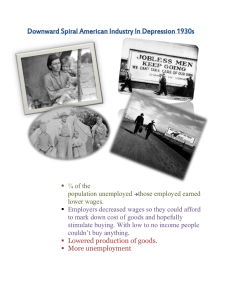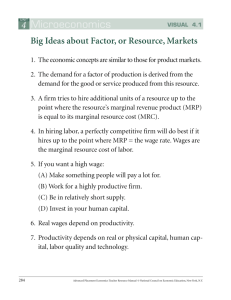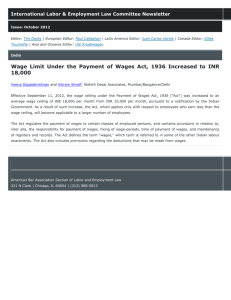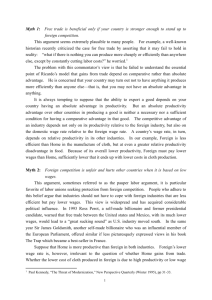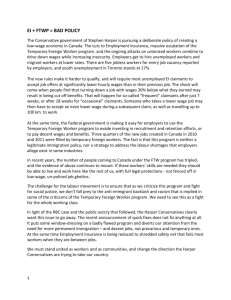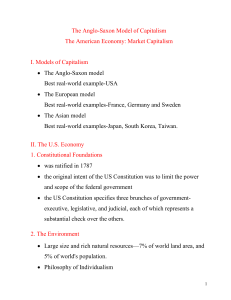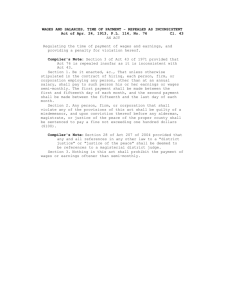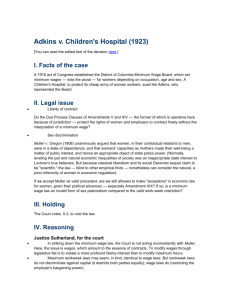A Raise for Fast Food Workers Will Help Western New York
advertisement
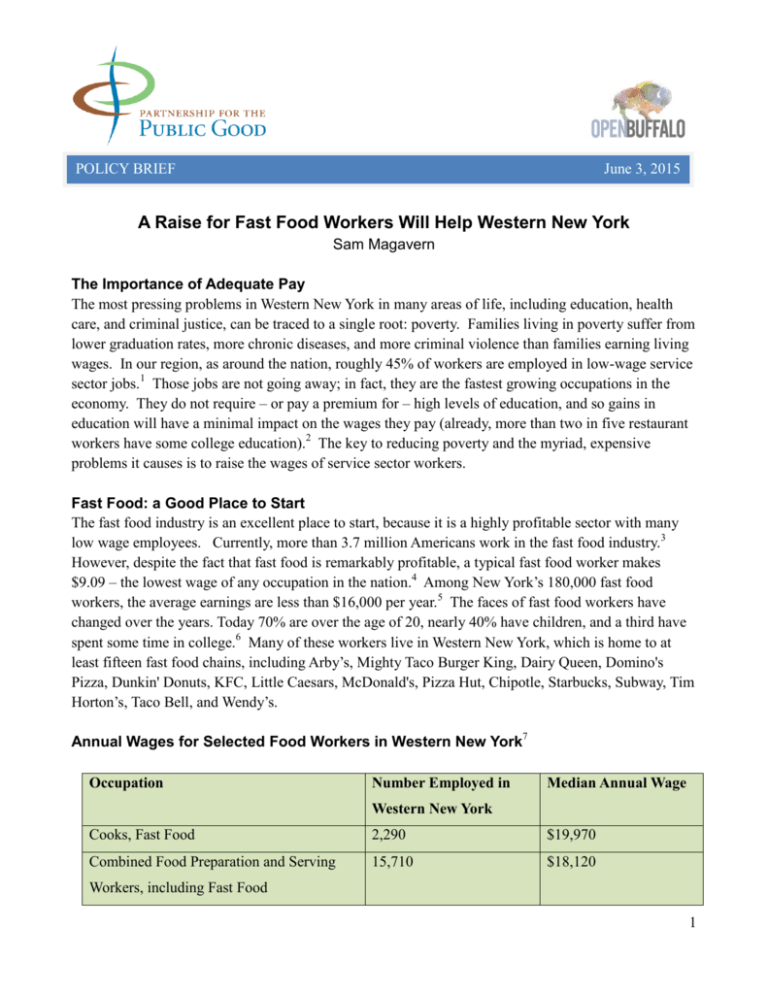
POLICY BRIEF June 3, 2015 A Raise for Fast Food Workers Will Help Western New York Sam Magavern The Importance of Adequate Pay The most pressing problems in Western New York in many areas of life, including education, health care, and criminal justice, can be traced to a single root: poverty. Families living in poverty suffer from lower graduation rates, more chronic diseases, and more criminal violence than families earning living wages. In our region, as around the nation, roughly 45% of workers are employed in low-wage service sector jobs.1 Those jobs are not going away; in fact, they are the fastest growing occupations in the economy. They do not require – or pay a premium for – high levels of education, and so gains in education will have a minimal impact on the wages they pay (already, more than two in five restaurant workers have some college education).2 The key to reducing poverty and the myriad, expensive problems it causes is to raise the wages of service sector workers. Fast Food: a Good Place to Start The fast food industry is an excellent place to start, because it is a highly profitable sector with many low wage employees. Currently, more than 3.7 million Americans work in the fast food industry.3 However, despite the fact that fast food is remarkably profitable, a typical fast food worker makes $9.09 – the lowest wage of any occupation in the nation.4 Among New York’s 180,000 fast food workers, the average earnings are less than $16,000 per year.5 The faces of fast food workers have changed over the years. Today 70% are over the age of 20, nearly 40% have children, and a third have spent some time in college.6 Many of these workers live in Western New York, which is home to at least fifteen fast food chains, including Arby’s, Mighty Taco Burger King, Dairy Queen, Domino's Pizza, Dunkin' Donuts, KFC, Little Caesars, McDonald's, Pizza Hut, Chipotle, Starbucks, Subway, Tim Horton’s, Taco Bell, and Wendy’s. Annual Wages for Selected Food Workers in Western New York7 Occupation Number Employed in Median Annual Wage Western New York Cooks, Fast Food 2,290 $19,970 Combined Food Preparation and Serving 15,710 $18,120 Workers, including Fast Food 1 The Public is Subsidizing Highly Profitable, Low-Wage Employers One reason that fast food employers can pay such low wages is that the public is picking up the tab for the difference between what workers receive in pay and what they need for food, rent, utilities, doctor’s visits, child care, and other basic necessities. For example, in Erie County, a household of four qualifies for food stamps if it earns less than $14.91 per hour. A household of two that makes less than $16.55 per hour qualifies for HEAP to help with heating bills. In New York, 60% of fast food workers rely on public assistance, at an average cost of $6,800 per year to the taxpayer. That means that the public is paying roughly $700 million per year to make up for low fast food wages. 8 The cost of public assistance for workers at fast food companies in the United States is nearly $7 billion per year.9 Fast food is the worst offender among the industries profiled in the recent UC Berkeley Study, “The High Public Cost of Low Wages,” which found that 73% of Living on Fast Food Wages enrollees in the major public assistance programs are working families.10 It would be much more efficient and Anthony Moore is a shift manager at less wasteful to ask companies to pay their workers living a Burger King. He earns $9 an hour, typically working 35 hours a week wages than for the public to continue to fill the gaps with and taking home around $300 needs-based programs. weekly. “It’s very inadequate,” said Mr. Moore, 26, who supervises 10 Fast Food Companies Can Afford to Pay Their workers. His rent is $600 a month, Workers More and he often falls behind on his It is striking that McDonald’s, Burger King, and other fast lighting and water bills. As a single food companies operate profitably in Denmark, where the father, he receives $164 a month in food stamps for his daughters, 5 and least they can pay a fast food worker is $20 per hour.11 2. “Sometimes I ask, ‘Do I buy food Equally striking is how lucrative the fast food industry is, or do I buy them clothes?’ ”Mr. and how much its executives are paid. In 2012, Moore’s daughters receive health McDonald’s earned profits of $5.46 billion and paid its care through Medicaid, while he is CEO $13.7 million.12 In 2012, fast food CEOs earned over uninsured because he cannot afford 1,200 times as much as the average fast food worker.13 Burger King’s coverage, he said. “I Accommodation and food services has the worst CEO-toskip the doctor,” he said, adding that he sometimes goes to work sick worker pay disparity of any sector in our economy, and fast because “I can’t miss the money.” food has the worst disparities within the accommodation and food services sector.14 In short, fast food is the most Liz Alderman and Steven Greenhouse. unequal of the unequal. "Living Wages, Rarity for U.S. Fast-Food Workers, Served Up in Denmark." New York Times, October 27, 2014 A recent report from the University of Massachusetts demonstrates that the fast food industry could raise wages to $15 per hour without shedding jobs or losing profitability due to four factors: Raising wages increases worker productivity and reduces turnover and training costs; The economy is growing, and the fast food sector is growing faster than the economy, so that some of the increased costs of paying more wages can be absorbed with increased revenues due 2 to growth; Businesses can reduce the pay of the highest paid workers or reduce profit margins while still remaining profitable; and Fast food businesses could raise prices slightly without losing customers.15 An abundance of economic research suggests that raising minimum wages does not reduce employment. One study examined pairs of counties located across state lines when one state raised its minimum wage and the other did not. They found no evidence that the higher wages harmed a state’s competitiveness by shifting business across the state line.16 A review of 64 studies on the impact of minimum wage increases on employment found little or no impact.17 Two of the Three Largest U.S. Employers of Low-Wage Workers are in Fast Food18 Highest Paid Profit Growth Over Last Exec’s Hourly Four Fiscal Years Compensation Yum Brands (Pizza Hut, $10,206 45% $2,037 130% Taco Bell, KFC) McDonald’s Fast Food: a Bad Choice for Taxpayer Assistance It is also worth noting that fast food companies do not produce valuable goods, nor do they export goods or services abroad. Rather, they compete for a limited pool of customers with other businesses. If the fast food industry were to shrink, then other restaurants, grocery stores, and businesses would grow by a corresponding amount, and there would be no net loss of jobs. In fact, jobs might grow because traditional restaurants are more labor-intensive than fast food restaurants. In fact, moving consumer dollars from fast food to other choices would be better for our health, environment, and economy. Fast food is an important contributor to the obesity epidemic because of its high fat and calorie content and low nutritional value. One study found that children who eat fast food consume 15% more calories than those who do not.19 University of Minnesota researchers found that people who ate fast food at least twice a week were 50% more likely to die of heart disease and 27% more likely to develop diabetes than those who did not.20 Fast food outlets and convenience stores worsen “food deserts” in low income areas by crowding out grocery stores and healthier options. The fast food industry is a major driver of factory farming and other environmentally harmful 3 practices.21 Finally, fast food chains tend to remove money from a local economy, rather than adding to it. For example, a study of Salt Lake City found that independently owned restaurants recirculated 78.6% of their revenue in the local economy, whereas national chains recirculated only 30.4%.22 Higher Wages Cut Turnover and Increase Productivity A survey of over 1,000 restaurant employers reported that higher wages cut turnover in half, saving the employers money on training and recruitment.23 As many service sector employers – including Costco, Trader Joe’s, and QuikTrip Convenience Stores – have found, investing in good jobs does not require charging customers more; rather, as business expert Tom Zeynep puts it, “even in supposedly low-skill service sector work, higher wages are the key to greater employee engagement, better customer service, higher productivity, and a better bottom line.”24 Wal-Mart and McDonald’s recently recognized that higher wages can be good for business when they raised wages for their lowest paid workers. McDonald’s announced it will increase the lowest wage by $1 an hour for employees working at its company-owned stores. However, only about 10% of McDonald’s 14,000 U.S. locations are corporate; the rest are owned by franchisees that chose their own pay structures.25 Furthermore, a one dollar raise still leaves McDonald’s workers mired in poverty and dependent upon public assistance for basic necessities. ________________________________________________________________________ Partnership for the Public Good For the Open Buffalo Innovation Lab www.ppgbuffalo.org www.openbuffalo.org 237 Main St., Suite 1200, Buffalo NY 14203 4 Notes 1 Richard Florida, “Building America’s Third Great Job Machine.” The Atlantic, May 2011; and Partnership for the Public Good, “Poverty-Level Work in Western New York,” November 2008. 2 Heidi Shierholz, “Low Wages and Few Benefits Mean Many Restaurant Workers Can’t Make Ends Meet.” Economic Policy Institute, August 21, 2014. 3 Statista, Number of employees in the United States fast food restaurant industry from 2004 to 2018, The Statistics Portal, (April 2015), http://www.statista.com/statistics/196630/number-of-employees-in-us-fast-food-restaurants-since-2002/. 4 Catherine Ruetschlin, “Fast Food Failure: How CEO-to-Worker Pay Disparity Undermines the Industry and the Overall Economy,” Demos (2014). 5 National Employment Law Project, “New York Department of Labor Wage Board for Fast Food Workers” (May 2015). 6 This Is the Face of Today's Fast Food Workers -- 70% of Whom Are over the Age of 20. "I Work in Fast Food and I'm Not a Teenager." CNNMoney. Cable News Network, n.d. Web. 02 Apr. 2015. <http://money.cnn.com/2014/05/30/news/economy/fast-food-educated-older/> 7 New York State Department of Labor, Occupational Employment Statistics, WNY Region, retrieved November 6, 2014 from http://labor.ny.gov/stats/lswage2.asp 8 National Employment Law Project, “New York Department of Labor Wage Board for Fast Food Workers” (May 2015). 9 Sarah Anderson and Betsy Wood, “Restaurant Industry Pay: Taxpayers’ Double Burden” Institute for Policy Studies (April 2014). 10 Ken Jacobs, Ian Perry and Jenifer MacGilvary, “The High Public Cost of Low Wages,” UC Berkeley Labor Center (April 2015). 11 Liz Alderman and Steven Greenhouse. "Living Wages, Rarity for U.S. Fast-Food Workers, Served Up in Denmark." The New York Times, October 27 2014 12 National Employment Law Project, “Super-Sizing Public Costs: How Low Wages at the Top Fast-Food Chains Leave Taxpayers Footing the Bill” (October 2013). 13 Catherine Ruetschlin, “Fast Food Failure: How CEO-to-Worker Pay Disparity Undermines the Industry and the Overall Economy,” Demos (2014). 14 Catherine Ruetschlin, “Fast Food Failure: How CEO-to-Worker Pay Disparity Undermines the Industry and the Overall Economy,” Demos (2014). 15 Robert Pollin and Jeannette Wicks-Lim, “A $15 U.S. Minimum Wage: How the Fast Food Industry Could Adjust Without Shedding Jobs. Political Economy Research Institute (January 2015). 16 Arindrajit Dube, T. William Lester, and Michael Reich, “Minimum Wage Effects Across State Borders,” The Review of Economics and Statistics, 92(4) (Nov. 2010). 17 Hristos Doucouliagos and T.D. Stanley, “Publication Selection Bias in Minimum Wage Research?” British J. of Indus. Relations, Vol. 47, Iss.2, (May 2009) 18 National Employment Law Project, “Big Business, Corporate Profits, and the Minimum Wage” (July 2012). 19 Jeanie Lerche Davis, “Fast Food Creates Fat Kids,” Web MD Health News, January 5, 2004. 20 University of Minnesota School of Public Health, “Fast food increases risk of diabetes, heart disease in Singapore.” Available at http://sph/umn.edu/fast-food. 21 See, for example, Corporate Accountability Initiative, “McDonald’s Influence on the Food System.” Available at https://www.stopcorporateabuse.org/our-food-system. 22 Indie Impact Series: a National Comparative Survey: Salt Lake City, Utah, available at http://localfirst.org/images/stories/SLC-Final-Impact-Study-Series.pdf. 23 Id.. 24 Richard Florida, “The Business Case for Paying Service Workers More,” CityLab, March 3, 2014, citing Tom Zeynep, author of The Good Jobs Strategy. 25 Samantha Sharf, “McDonald's To Raise Wages: Will It Be Enough?” Forbes (April 2015). 5
